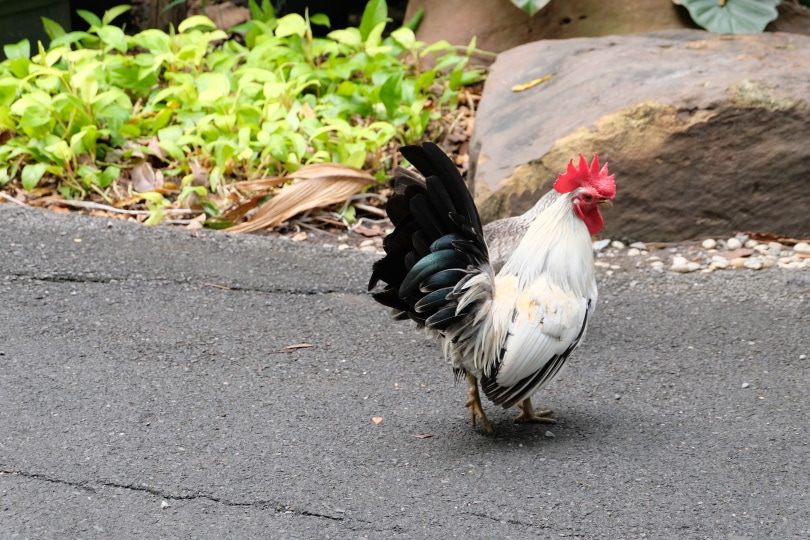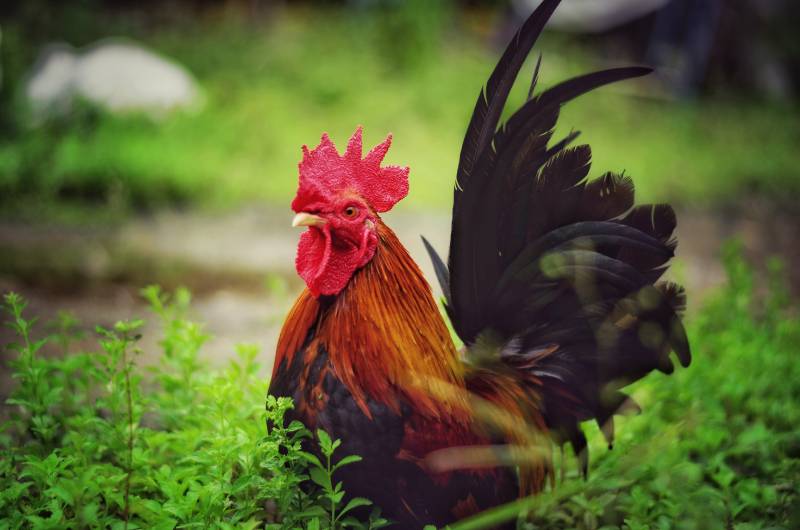
The Japanese Bantam chicken is also known as the “Chabo,” which means “bantam,” “miniature” or “dwarf.” They get their name rightfully, as they are a true Bantam breed known for their extremely short legs and petite stature.
These birds are only used for exhibition and companionship purposes, as they are not ideal for meat or laying. According to the American Bantam Association, the breed is among the list of most popular chicken breeds.
 Quick Facts About Japanese Bantam Chickens
Quick Facts About Japanese Bantam Chickens
| Breed Name: | Japanese Bantam, Chabo |
| Place of Origin: | Japan |
| Uses: | Showing, Companionship |
| Rooster (Male) Size: | 1.1 – 1.3 lbs. |
| Hen (Female) Size: | 0.88 – 1.1 lbs. |
| Color: | Birchen gray, black mottled, blue mottled, blue-red, brown-red, buff Columbian, cuckoo, dark gray, golden duck wing, lavender, Miller’s gray, partridge, red mottled, silver-gray, tri-colored, wheaten. |
| Lifespan: | 10-13 years |
| Climate Tolerance: | Not Cold Hardy |
| Care Level: | Difficult |
| Production: | Exhibition |
Japanese Bantam Origins
The origins of the Japanese Bantam chicken breed are somewhat of a mystery, but the earliest depiction of the breed is dated back to a painting from 1660. DNA evidence suggests that all the Japanese breeds of ornamental chicken were the product of the selective breeding of fighting birds. They were raised as ornamental garden birds and were displayed by the Japanese upper class.
Exportation of the Japanese Bantam began in the 1860s when Japanese foreign trade was reopened. They were confirmed to have reached Great Britain around this time. By the year 1912, a breed society was established during the Crystal Palace Poultry Show and by 1937, an international breed club called the Chabo Bantam Club was formed.

Japanese Bantam Characteristics
As mentioned, the Japanese Bantam is a very petite chicken with short legs. They have a graceful, arched tail and very large wings. Their unique look and specific traits are what kept them as strictly ornamental birds.
They are generally very easy to tame and overall, a friendly and docile breed, though roosters have been known to get aggressive. The breed is not hardy at all and cannot tolerate cold easily, as the combs and wattles are prone to frostbite. Their small size means they don’t require as much space, but they do not take well to confinement. They require a very clean and tidy housing environment since their long wings touch the ground and can become soiled easily.
The Japanese Bantam is typically a good flier. The hens make excellent mothers even though they are poor layers that produce only 1 to 2 small eggs per week. Their size doesn’t make them favorable for meat production. They are difficult to breed due to their physical traits and the gene that causes the short legs can be lethal.
About 25% of Japanese Bantam chicks will pass away before hatching and an additional 25% will likely be born with long legs. Typically, only half the eggs will produce short-legged, true Japanese Bantams. The breed certainly has extra care requirements and is a bit more fragile than other varieties.
Uses
The Japanese Bantam is strictly an ornamental breed of chicken. They are not used for practical purposes like meat or eggs but are kept for showmanship and companionship. Their use for exhibition makes them stand out to breeders looking for a unique and interesting show breed but anyone looking for a good laying or meat bird will want to keep searching for something more suitable for their needs.

Appearance & Varieties
Japanese Bantams are very small and petite chickens with very short legs, large combs, and an arched tail that is nearly as big as they are. Hens typically only weigh up to 1.1 pounds while Roosters are just slightly heavier and can reach up to 1.3 pounds. The breed only reaches about 12 inches at maximum height.
Japanese Bantams have many different color variations, some that are accepted in the Standard of Perfection and some that are not. The accepted color varieties of the Japanese Bantam include birchen gray, black mottled, blue mottled, blue-red, brown-red, buff Columbian, cuckoo, dark gray, golden duck wing, lavender, Miller’s gray, partridge, red mottled, silver-gray, tri-colored, and wheaten.
The combs, wattles, and earlobes of the breed are red and large on the rooster but more average-sized on the hens. They have dark brown eyes with yellow skin and beaks. The wings are very large and held at a downward angle, causing them to touch the ground thanks to their tiny legs.
Population/Distribution/Habitat
Having been developed in Japan during the 7th century, the Japanese Bantam didn’t begin to grow in popularity until the 1800s due to Japan’s lack of foreign trade. The breed was exported to Europe where it was officially established, featured in shows, and the breed societies began to form.
Today, the Japanese Bantam is spread throughout the world and continues to be a very popular bird. Even those that don’t keep or show the breed are aware of the name.

Are Japanese Bantam Good for Small-Scale Farming?
Japanese Bantams are not a good breed for small-scale farming operations. Since the breed only serves the purpose of exhibition and companionship, there are many other breeds of chicken that would be much better suited for small-scale farming.
While they are interesting birds in terms of looks and personality, they are sensitive to weather conditions, are poor layers, and their small size makes them impractical to use for meat production. Even those looking for a small meat bird would be better suited with Cornish Game Hens.
 Conclusion
Conclusion
The Japanese Bantam is an interesting and popular chicken breed that is only used by poultry breeders in show settings. They are not a very hardy breed, and their physical traits make them a little higher maintenance in terms of care and a challenge to breed. They may not be ideal as a layer or for meat production, but they are a friendly breed that will certainly keep heads turning.
Featured Image Credit: Pound Constantine, Shutterstock
 Quick Facts About Japanese Bantam Chickens
Quick Facts About Japanese Bantam Chickens





